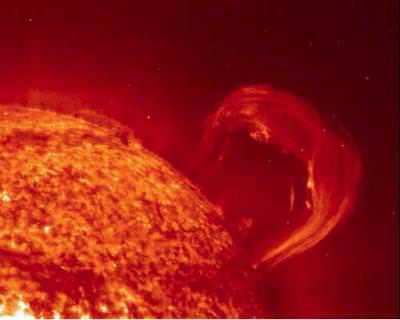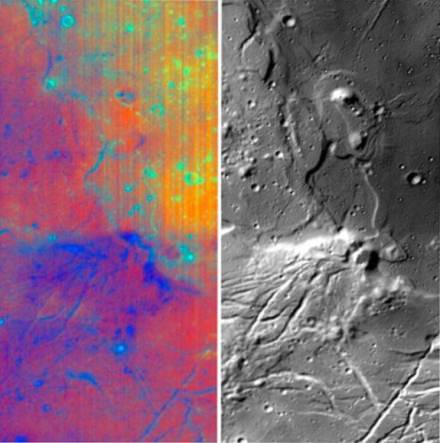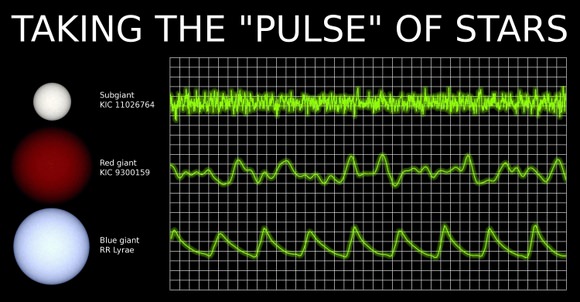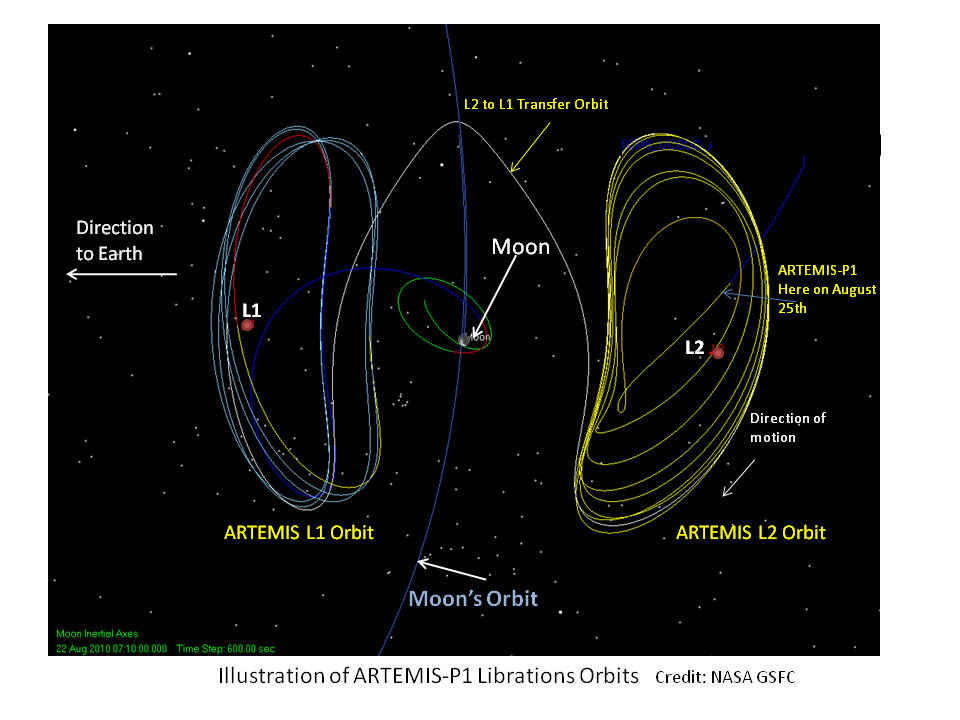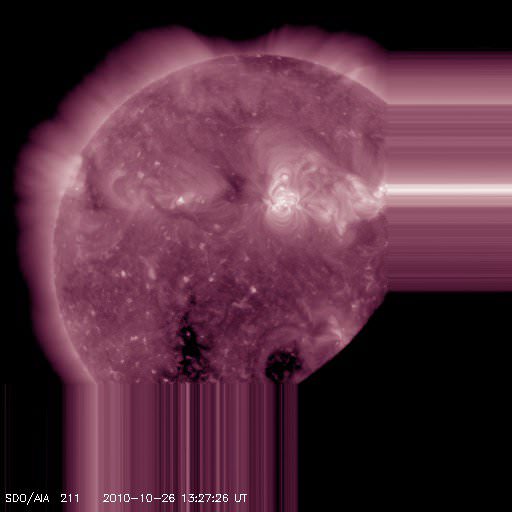Emily Lakdawalla at the Planetary Society blog unearthed some really cool videos taken by the Chinese Chang’E 2 spacecraft at the Moon. The five engineering videos include Chang’E 2’s solar panel deployment, orbit insertion burn, the first and second orbital trim maneuvers, and low lunar orbit. They are all especially unique in that the video not only includes images from the Moon’s surface, but also the spacecraft itself can be seen, providing a perspective that is not often seen. The video above is of Chang’E 2’s second orbit trim maneuver. Check out Emily’s post to see all five, plus she provides great insights into the video clips, as well.
Confirmed: Hayabusa Nabbed Asteroid Particles
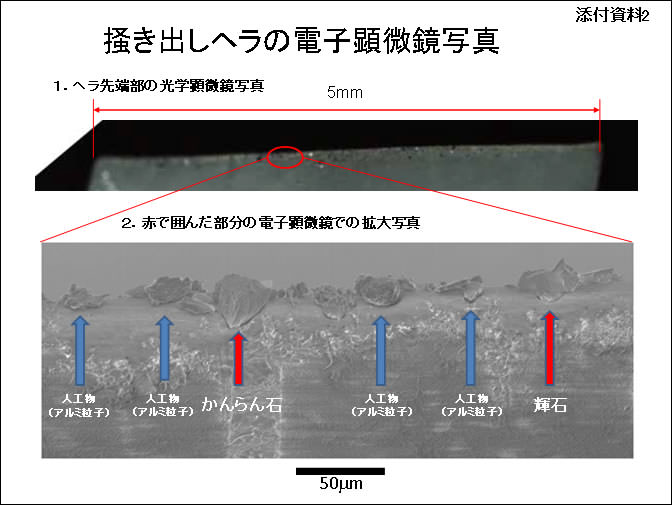
[/caption]
The Japan Aerospace Exploration Agency (JAXA) has confirmed that the tiny particles inside the Hayabusa spacecraft’s sample return container are in fact from the asteroid Itokawa. Scientists examined the particles to determine if the probe successfully captured and brought back anything from the asteroid, and in a press release said “about 1,500 grains were identified as rocky particles, and most were determined to be of extraterrestrial origin, and definitely from Asteroid Itokawa.”
These are the first samples from an asteroid ever returned to Earth; the only other extraterrestrial samples brought back to Earth came from the Apollo missions to the Moon. See correction, below.
Previously, JAXA said that although particles were inside the container, it wasn’t clear if they were from the asteroid or if they could be of terrestrial origin (dust from Earth that could have been inside the container).
The particles samples were collected from the chamber by a specially shaped Teflon spatula and examined with a scanning electron microscope. There were two chambers inside the container, and from the press release (in Japanese) it appears all the particles were found in one chamber, Chamber A.
Most of the particles are extremely small, about 10 microns in size and require special handling and equipment. Unfortunately they aren’t the “peanut-sized” chunks of rock that the mission originally hoped to capture. This will make analyzing the particles difficult, but not impossible.
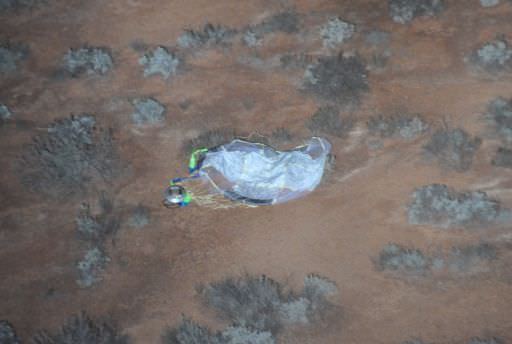
During the seven-year round trip journey, Hayabusa arrived at Itokawa in November, 2005. The mechanism that was intended to capture the samples apparently failed, but scientists were hopeful that at least some dust had made its way into the return canister. After a circuitous and troubled-filled return trip home, the sample return capsule was ejected and landed in Australia in June of this year.
Here are the other successful sample return missions:
Apollo Moon missions (1969-1972)
Soviet Union’s Luna 16 (1970) returned 101 grams of lunar soil
Luna 20 (1974) returned 30 grams
Luna 24 (1976) returned 170.1 grams.
The Orbital Debris Collection (ODC) experiment, deployed on the Mir space station for 18 months during 1996–1997, used aerogel to capture interplanetary dust particles in orbit.
Genesis (2001-2004) captured and returned molecules collected from the solar wind. It crashed in the Utah desert, but samples were able to be retreived.
Stardust (1999-2006) collected particles from the tail of a comet, as well as a few interstellar dust grains.
Source: JAXA
Solar Explosions Spark Controversy
[/caption]
Nowhere in the Solar System are conditions more extreme than the Sun. Every second it converts millions of tons of matter into energy to create the intense levels of heat and light we expect of our local star. Study the Sun in different wavelengths and its violent nature can really become apparent. The STEREO satellite has been studying the Sun at a wavelength of 304Å and the results support a controversial solar theory.
Coronal Mass Ejections (or CMEs) are common on the Sun and they have a very real impact to us here on Earth. The solar explosions expel trillions of trillions of tons of super hot hydrogen gas into space, sometimes in the direction of the Earth. Traveling at speeds up to 2,000 kilometers per second it takes just a day for the magnetized gas to reach us and on arrival it can induce strong electric currents in the Earth’s atmosphere leading not only to the beautiful auroral displays but also to telecommunication outages, GPS system failures and even disturbances to power grids.
Solar flares, to use their other name, were first observed back in 1859 and since then, scientists have been studying them to try to understand the mechanism that causes the eruption. It has been known for some time that the magnetically charged gas or plasma is interacting with the magnetic field of the Sun but the detail has been at best, elusive.
In 2006, the international satellite STEREO was launched with the objective of continuously monitoring and studying the CMEs as they head toward the Earth and its data has helped scientists at the Naval Research Laboratory (NRL) in Washington, D.C., start to understand the phenomenon.
Using this new data, scientists at the NRL compared the observed activity with a controversial theory that was first proposed by Dr James Chen (also from the NRL) in 1989. His theory suggested that the erupting clouds of plasma are giant ‘magnetic flux ropes’, effectively a twisted up magnetic field line shaped like a donut. The Sun being a vast sphere of gas suffers from differential rotation where the polar regions of the Sun and the equatorial regions all rotate at different speeds. As a direct result of this, the plasma ‘drags’ the magnetic field lines around and the Sun and it gets more and more twisted up . Eventually, it bursts through the surface, taking some plasma with it giving us one of the most dramatic yet potentially destructive events in the Universe.
Dr Chen and a Valbona Kunkel, a doctorate student at George Mason University, applied Dr. Chen’s model to the new data from STEREO and found that the theory agrees with the measured trajectories of the ejected material. It therefore looks like his theory, whilst controversial may have been right all along.
Its strange to think that our nearest star, the Sun, still has secrets. Yet thanks to the work of Dr. Chen and his team, this one seems to have been unraveled and understanding the strange solar explosions will perhaps help us to minimise impact to Earth based technologies in years to come.
Mark Thompson is a writer and the astronomy presenter on the BBC One Show. See his website, The People’s Astronomer, and you can follow him on Twitter, @PeoplesAstro
Two New Kinds of Moon Rocks Found
[/caption]
Scientists analyzing data from the Moon Mineralogy Mapper instrument or M Cubed, on the Chandrayann-1 spacecraft found two different kinds of never-before-seen lunar rocks – one hidden in a basin on the far side of the Moon and the other staring right at us on the near side. Just four minerals — plagioclase feldspar, pyroxene, olivine, and ilmenite — account for 98-99% of the crystalline material of the lunar crust, but the composition of these newly found rocks are two different kinds of spinels, a magnesium spinel and a chromite spinel. The composition and location of these new rock types are extremely puzzling, and lunar scientists are trying to determine more details about these mysterious Moon rocks.
Universe Today talked with Dr. Carle Pieters from Brown University who is the Principal Investigator for M Cubed as well as Dr. Jessica Sunshine from the University of Maryland, a co- investigator with the project.
Universe Today: Dr. Pieters, tell us about the newly found rocks on the far side.
Dr. Carle Pieters: The rock type on the far side of the Moon that is so unusual is a magnesium spinel, which typically has iron, magnesium, and aluminum oxide. In looking in detail at the spectral properties of the Moscoviense Basin on the far side — and in particular the material along the inner-most ring of this basin — we noticed there were a few little areas that were spectroscopically unusual. So, of course we investigated those in more detail. We saw three primary different compositions, and two we understand and had seen elsewhere, and they are rich in iron bearing minerals called pyroxene and olivine, and we saw small areas of these that are widely separated.
But then the third kind of mineral, the magnesium spinel, we had never seen before on the Moon, and what is interesting is not only is there an unusual abundance of this particular mineral, but it also has a lack of the pyroxenes and olivines that we see elsewhere. So there are several mysteries that are interwoven here. One, is why do we have a concentration of this spinel mineral and however it got concentrated in this area, why aren’t the other minerals that we are familiar with also there, because they are not.
So this is a big mystery and it is a very exciting one because now we have to reexamine our understanding of the character of the lunar crust, in particular to the depths that might have been tapped by this enormous basin and that we are now looking at as exposed on the surface.
Universe Today: So, what does this tell you about this region on the Moon?
Pieters: Not only are these unusual areas compositionally, and they are only about a kilometer or two in size, but in every method we’ve been able to look at thus far, in every wavelength and resolution, they have no other distinguishing properties. Typically, on the Moon to indentify an usual composition we look for a fresh crater that has excavated and exposed material on the surface of the Moon. These areas have no fresh craters, no disturbance at all across their surface, even at the highest resolution that is seen with the LROC (Lunar Reconnaissance Orbiter Camera) instrument which measures a half a meter resolution.
These are old surfaces that have been undisturbed but have an extremely unusual composition. And even the space weathering that has occurred on the surface throughout the billions of years of history on the Moon has not erased their unusual compositions. So, they are unusual for the kind of compositions we see, but they are also unusual because they have no identifying property that allows us to identify them in our imagery which is quite unusual for features on the surface of the Moon.
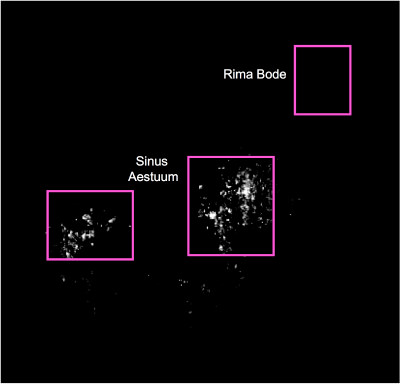
Universe Today: Now let’s move to the near side of the Moon, where Dr. Jessica Sunshine and her team went looking for unusual data.
Dr. Jessica Sunshine: One of the things I was asked to be in charge of was looking for anomalies, things that just didn’t look like the rest of the Moon. And of course you never know what’s going to happen under those circumstances. Carle had already discovered there seemed to be a magnesium spinel on the far side of the Moon and I went looking to see where else it could be. We found that the only place that we had anything that looked like the spinel mineral in the data we had was on the near side and it was an extremely large deposit in the middle of the central nearside, almost exactly dead center at zero-zero. And we started looking a little more carefully and realized that it wasn’t really the same kinds of things that Carle found, which truly was a new rock type on the far side of the Moon, but something really usual about the region.
We had already known the region was full of what we call dark mantle deposits or pyroclastic deposits, which is firefountaining deposits. This came from explosive eruptions of lava and gas over large areas of the Moon, about the size of Massachusetts. And we knew that three of them were there, it just turned out that one of them was compositionally different from the other ones, and in particular it had the kind of spinel which is a chromite, because it has chrome in it, and now we’re busy trying to figure out why this deposit is different from the one next door, and what does it mean. And we’re still working that process out as we speak.
Universe Today: What is it like to find something new like this on the side of the Moon that humans have been able to see for thousands of years?
Sunshine: Yes, I tend to title my talks on the subject something like, “Hidden in Plain Sight” because they are! It’s right there and I think this is a really fascinating part of this because we have been starring at the Moon, as humanity for millennia and if our eyes were slightly different we would see this one really dark spot in the middle of the Moon that is different from anywhere else.
Universe Today: What specifically about the Chandrayaan-1 spacecraft and the Mcubed instrument made these discoveries possible?
Sunshine: M Cubed collects data over a much broader range of light than our human eyes can. We can all see the rainbow, we’re all familiar with that, from blue to red, but there is light at shorter wavelengths, which we call ultraviolet, and particularly for this case, there is light at shorter wavelengths called infrared. M Cubed goes farther into the infrared than humans can see and it is there we are able to see diagnostic fingerprints of different kinds of minerals. So I suspect there are certain kinds of bugs who would look at the Moon and would have known these deposits are there because their vision goes into the infrared!
Universe Today: So, Dr. Pieters, does these new discoveries tell us there are still more mysteries to find on the Moon?
Pieters: Oh, absolutely! We’ve just barely scratched the surface here. This is thrilling from a spectroscapist’s point of view, of course, but also from someone who is trying to understand how planets work, and in particular how this wonderful small body in our neighborhood is telling us about the characteristics of crustal evolution and fundamental properties of planetary surfaces.
You can listen to a version of this interview on the 365 Days of Astronomy podcast and the NASA Lunar Science Institute podcasts
Discovery’s Final Mission Scrubbed 24 Hours Due to Weather
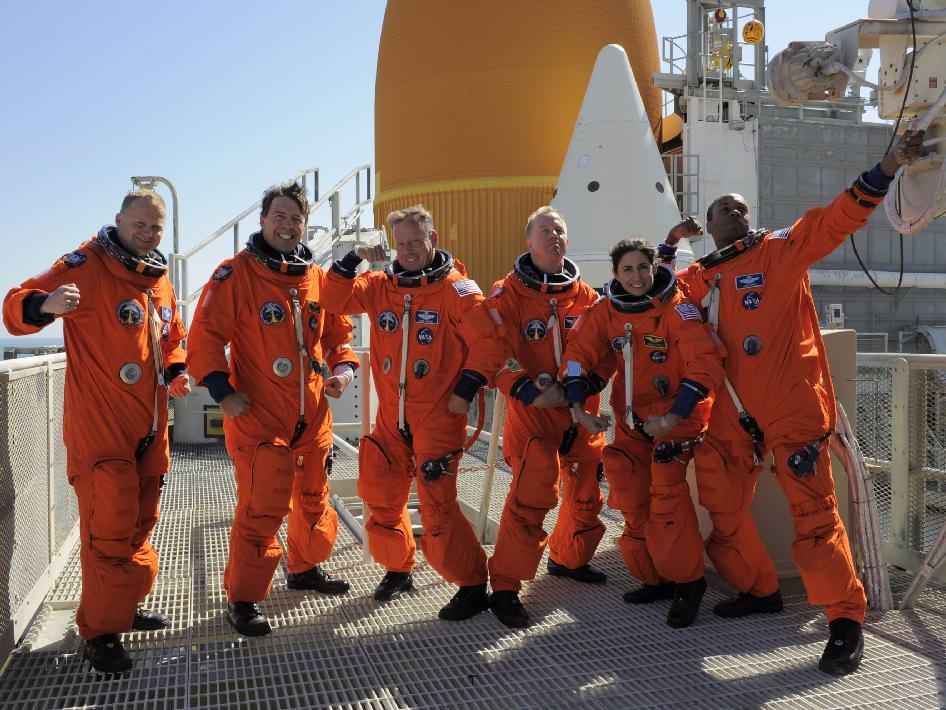
[/caption]
Discovery’s final flight faced its first hurdle in the form of a fuel leak in its right OMS pod. This problem seemed solved, but using an over-abundance of caution mission managers had the seals around the affected flange replaced. Then unrelated leaks of hydrogen and helium pushed the launch back to Nov. 2 and then Nov. 3. With that problem resolved many thought Discovery’s problems were behind her – enter a voltage issue in the number three engine’s backup control system. This conspired to push the launch back to Nov. 4.
However, in the early morning hours of Nov. 4 it was obvious that Florida’s turbulent weather would not allow a launch on this day and mission managers scrubbed the launch for at least 24 hours. Weather for Friday shows a 70 percent chance of favorable conditions. If Discovery does launch tomorrow, it will take place at 3:04 p.m. EDT.
Discovery’s final mission, STS-133, will deliver the Leonardo Multipurpose Module (PMM) with its cargo – including the first humanoid robot to be sent into space – Robonaut-2 (R2). Also riding along on this mission is the Express Logistics Carrier-4 and spare parts. Like the other remaining shuttle flights, these new components and supplies are designed to leave the space station better prepared for when the space shuttles are retired next year.
The crew of STS-133 will be comprised of Commander Steve Lindsey, Pilot Eric Boe and Mission Specialists; Alvin Drew, Nicole Stott, Tim Kopra and Michael Barratt. All of these astronauts are space flight veterans.
Kepler Spacecraft Can “Hear” a Red Giant Concerto in Space
[/caption]
Not only is the Kepler spacecraft hunting down extrasolar planets, but it also provides the ability to study stars in unprecedented detail. “We knew that if Kepler had the sensitivity of detecting Earth-size planets, that it would have capability to transform our knowledge of stars themselves,” said Natalie Batalha of San Jose State University in California, a co-investigator on the Kepler Astroseismic Science Consortium. This international partnership of over 400 astronomers uses the Kepler spacecraft to “listen” to tiny oscillations, or “star quakes,” in red giant stars, allowing scientists to do groundbreaking work in deducing the fundamental properties of stars.
In just the first year of Kepler’s operation, the team has been able to study thousands of stars using astroseismology, while previously only a few dozen of stars had been “listened to” using this technique.
“We can say Kepler is listening to thousands of musicians in the sky,” said Daniel Huber, a graduate student at the University of Sydney, during a webcast of a press conference about the new findings.
“From first year of the Kepler mission we moved from having a couple of dozen of stars with a couple of weeks of data,” said Travis Metcalfe, scientist at The National Center for Atmospheric Research, responding to a question posed by Universe today “to having one month to study each of a several thousands of stars. This is an enormous expansion of our capability to study this type of star and what the oscillations tells us.”
Similar to how seismologists study earthquakes to probe the Earth’s interior, astroseismology measures the natural pulse of light waves from stars to gain new insights into stellar structure and evolution.
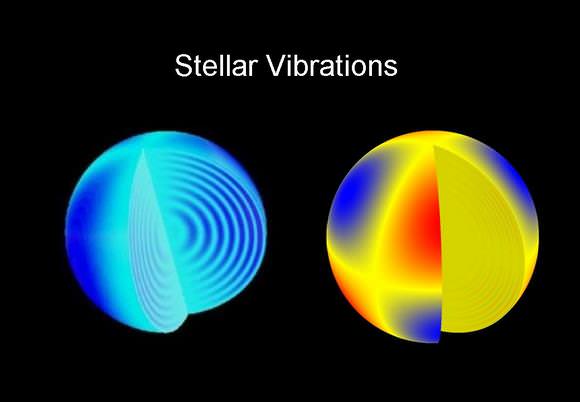
“Kepler allows us to study the periods of stellar oscillations, and we use them to study the cores of stars — in a way to touch the stars — and get the most accurate measurements of stars we have ever made,” said Hans Kjeldsen, associate professor, KASC, Aarhus University in Denmark.
They can measure size and age with extreme precision and they have now characterized the structure and life cycle of over 1,000 red giants. What they have found so far confirms the current principals of stellar evolution and allows for better predictions of what might happen to our Sun in several billion years.
Kjeldsen said they are getting data of amazing quality. “We can now actually study stars of all phases and evolutionary stages, of different mass, and all different types. This is the amazing thing for me. Instead of looking one star for awhile and then moving on to next star, we now have access to thousands of stars at once. And having said that, there are still thousands and thousands of stars we still need to study.”
Metcalfe said astroseismology listens to the oscillations of the star, and can hear a tone so low that even a whale would have a hard time hearing it. Kepler can see even tiny oscillations as a flickering in the star.
“Sound waves travel into the star and bring information up to the surface, which Kepler can see as a tiny flickering in brightness of the star,” said astronomer Travis Metcalfe of The National Center for Atmospheric Research.
That flickering has a tone like the notes of a musical instrument. “We essentially measure the tone of these musical notes from the star,” he said. “Larger stars flicker in lower tones while smaller stars in higher tones.”
Listen to Daniel Huber's Red Giant Oscillation Symphony
One star that Metcalfe has been focusing on is a red giant, that measured twice the size of the Sun. KIC 11026764 now has the most accurately known properties of any star in the Kepler field. In fact, few stars in the universe are known to similar accuracy, the team said. The oscillations reveal that this star is 5.94 billion years old and is powered by hydrogen fusion in a thin shell around a helium-rich core.
In this consortium, no dollars are actually exchanged between nations. The US provides the Kepler instrument and software pipeline, while the international partners are supplying human resources of ingenuity and scientific expertise.
“We’re not just getting a great legacy of scientific results, but also a valuable symbiosis and partnership here,” said Batalha.
You can watch the press conference on Universe Today at this link.
Earth Orbiting Satellites Maneuvered to Now Study the Moon
In another case of NASA reusing and recycling spacecraft, two of the five THEMIS spacecraft — which were studying the cause of geomagnetic substorms here on Earth — have a new mission. They made some very unique and complex maneuvers to reach two different LaGrange Points, and will turn their focus on the Moon. Particularly, they will try to determine how the solar wind electrifies, alters and erodes the lunar surface. This is timely since the discovery last year of water across the surface of the Moon which may be created by the solar wind interacting with the lunar surface.
The original THEMIS mission (Time History of Events and Macroscale Interactions during Substorms) featured five satellites that have now successfully completed their 2 year mission. Because they are continuing to work perfectly, NASA is re-directing the outermost two spacecraft to special orbits at and around the Moon. This new mission, which is called ARTEMIS: Acceleration, Reconnection, Turbulence and Electrodynamics of the Moon’s Interaction with the Sun.
[/caption]
It took more than a year and nearly all remaining fuel aboard the satellites to get them to the L1 and L2 Lagrangian points, where one is located on the far side of the Moon, and the other on the Earth-facing side. ARTEMIS-P1 is the first spacecraft to navigate to and perform stationkeeping operations around the Earth-Moon L1 and L2 Lagrangian points.
On August 25, 2010, ARTEMIS-P1 reached the L2 Lagrange point on the far side of the Moon. Following close behind, ARTEMIS-P2 entered the opposite L1 Lagrange point on Oct. 22nd.
Recently, one of the spacecraft was hit by a meteoroid but still seems to be operating.
As the Moon orbits the Earth, it passes in and out of the Earth’s magnetic field and the million-mile per hour stream of solar wind particles. While in these regions, the two ARTEMIS spacecraft will seek evidence for turbulence, particle acceleration, and magnetic reconnection, three fundamental phenomena that control the nature of the solar wind’s interaction with the Earth’s magnetosphere.
By using their instruments and unique two-point vantage points, the spacecraft will study the vacuum the Moon carves out in the solar wind, and the processes that eventually fill this lunar wake. Nearer the Moon, they will observe the effects of surface electric fields, ions sputtered off the lunar surface, and determine the internal structure of the Moon from transient variations in its magnetic field induced by external changes.
Spacecraft Calibrations Provide Unique Solar “Artwork”
[/caption]
If you check out the Solar Dynamics Observatory website today to get an update of what the Sun is doing, (which you should -everyday!) you may have noticed a few of the daily images appeared to be “sliding” across the screen. That’s because yesterday the team from the AIA instrument (Atmospheric Imaging Assembly) performed several instrument calibration maneuvers, in which the AIA boresight was moved away from the center of the Sun. When the images are re-centered some of them have lines to the edges of the picture, creating some very nifty solar artwork. Enjoy them now, as this effect will only show up in the “rapid” images shown on their website, and later, they’ll be corrected in the science database. See more below.
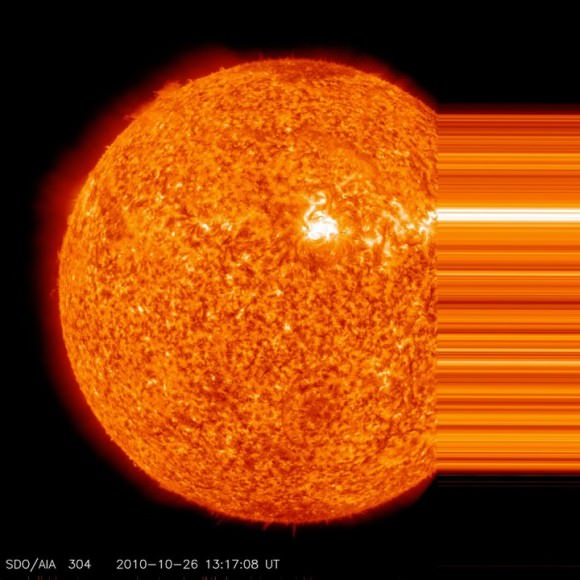
SDO takes images of the Sun in several different wavelengths, which highlights different features. On SDO’s Facebook page, the team wrote, “It appears that the re-centering of the images is copying the value at the edge of the field of view rather than zero while the image is being shifted to the center of the picture.”
And even though the images will be fixed, they won’t be able to fix them completely. The information that is missing from images can’t be recovered because the instrument wasn’t pointed at the Sun at the time the image was taken.
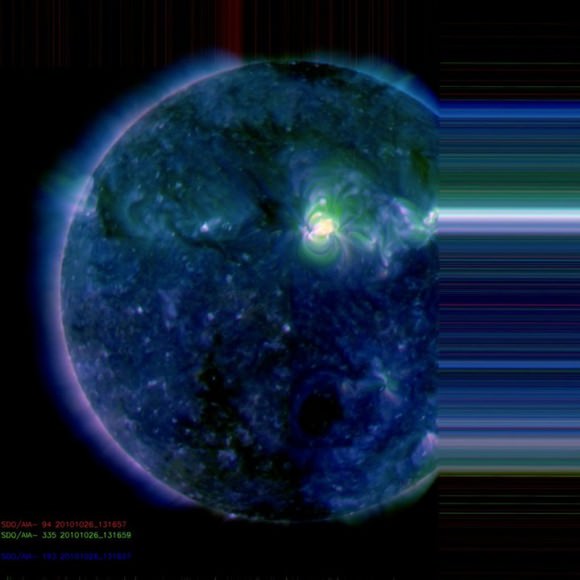
Watch a Mars Rover Under Construction – LIVE!
If you are tired of the drama of your favorite reality TV show, it might be time to switch things up a bit. The most recent reality show, available ad free on the internet, features a spunky robot and a huge cast of characters. The spunky robot is Curiosity, the name of the Mars Science Laboratory rover. The characters are all wearing white clean room “bunny suits,” so it will be difficult to tell them apart. Surely, if you spend enough time watching you’ll be able to discern who’s who.
In all seriousness, you can watch the construction of Curiosity live via Ustream. The NASA/JPL team that is constructing the rover will be at work between 8 a.m. to 11:00 p.m. PDT Monday through Friday. Otherwise, things will be a little quiet. The camera looks out onto a pretty active part of the clean room, but they may move the rover outside of the view of the camera. Some of the busy periods will be archived at the bottom of the Ustream feed, so if you end up watching during a quiet period, take a look at those while you’re waiting for the next work period to start up.
For more on the rover and its mission, visit the mission page or see our story on Universe Today from September, “5 Things about the Next Mars Rover“.
Source: JPL
Understanding the Unusual LCROSS Ejecta Plume
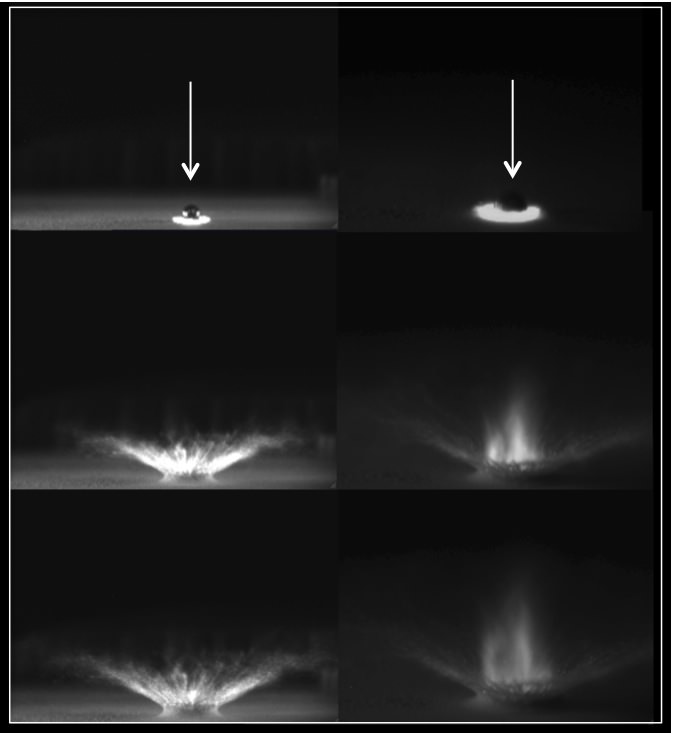
LCROSS was an unusual mission, in that it relied on an impact in order to study a planetary body. Not only was the mission unusual, so was the ejecta plume produced by slamming a hollow Centaur rocket booster into the Moon.
“A normal impact with a solid impactor throws debris out more than up, like an inverted lampshade that gets wider and wider as it goes out,” said Pete Schultz, from Brown University and a member of the LCROSS science team. “But the configuration of a hollow impactor — the empty rocket booster — created a plume that had both a low angle plume but more importantly, also a really prominent high angle plume that shot almost straight up.”
This high plume elevated the debris enough so it was illuminated by sunlight, and could be studied by spacecraft.
Even though the plume wasn’t seen from Earth, as was advertised prior to the impact, it was seen by the both the LCROSS shepherding spacecraft and the Lunar Reconnaissance Orbiter. Using the spent Centaur was not so much by mission design as using what was available. But it turned out to be a great choice.
“I think we were quite fortunate,” Schultz told Universe Today in a phone interview this week. “I think another design, and we may have gotten a very different result. Not much debris may have come up into the sunlight and the plume would have been very temporary.”
In order for the debris to get high enough to come into sunlight, it had to rise up about a half mile above the bottom of the crater.
“To put this into perspective,” said Schultz, “we had to throw debris up twice the height of the Sears Tower, the tallest building in the US. Now the Moon has less gravity, so if we bring it back down to Earth and compare it, it is like trying to throw a ball to the top of the Washington Monument. So there is a lot of gravity to overcome, and it turns out that this impact did it because we used a hollow impactor.”
When the rocket booster hit and the crater began to form, the lunar surface collapsed and shot upwards – almost like a jet – towards the sunlight, carrying with it the volatiles that had been trapped in the regolith.
In order to figure out what the impact was going to look like, Schultz and his team, which included graduate student Brendan Hermalyn, did small scale impacts and modeling. Their tests were only done a couple of months before the actual impact, and used small half-inch projectiles into different surfaces.
“Most impacts, when we model them, we assume the impactors are solid,” Schultz said. “We did experiments, with both solid and hollow projectiles, and when we used the hollow projectile, we had a real surprise. We not only saw the debris moving outward, but also upward.”
“We really didn’t know exactly what we were going to see in the actual LCROSS impact, but our tests explained a lot,” Schultz continued, “explaining why we saw what we did and why we saw the plume for such a long time. If it had been coming out like an inverted lampshade or a funnel expanding, the debris would have come up and gone back down, and probably would have been done within about 20 seconds. Instead, it just kept on coming.”
But there were some expected moments. As the LCROSS shepherding spacecraft approached the lunar surface, Tony Colaprete and the team readjusted the exposures on the cameras and the team was able to actually see the surface of the Moon in the final seconds before impact.
“That was great,” Schultz said. “That means we got to see the crater, we were able to get an estimate on how big the crater was, and it made sense with what our predictions had said. But we were also able to see the remnants of this high angle plume still returning to the surface. This must have been shot almost straight up into space, and was now coming back to the Moon. We saw it as a very diffuse cloud, and saw the remaining portions of the regolith coming back down, like a fountain. To me, that was the most exciting part.”
Schultz said he was nervous during the impact.
“I have to confess, we were on pins and needles,” he said, “as this was something much bigger than the experiments of using half inch projectiles and we didn’t know if it was going to scale up. We were dealing with something that looked like schoolbus with no children aboard that was slamming into the Moon and we didn’t know if that was going to behave in the same way as our smaller models.”
And even though the plume did act like the models, there were plenty of surprises — both in the impact and what has now been discovered to exist in Cabeus Crater.
“We knew when it was going to hit the surface – we know how fast how we were going and where we were above the surface — and it turned out there was a delay before we saw the flash and that was really a surprise,” Schultz said. “It was about a half second delay and then it took about a third of second delay before it began to rise and get brighter. The whole thing took seven-tenths of a second before it began to get bright. That is hallmark of a fluffy surface.”
Schultz said they know that it was likely a “fluffy” surface from the experiments and modeling, and from comparisons with the Deep Impact mission, for which he was a co-investigator.
“One of the first things we realized was that this is not your normal regolith — what you usually think of for the Moon,” Schultz said. “We watched the flash, and we looked for what type of spectra we saw. The spectra has the fingerprints of the composition of the elements and compounds. We were expecting because of the low speed we actually wouldn’t get to see much. But instead we immediately got a couple of hits, we got to see a sudden emission of OH, which is a characteristic at this wavelength of a byproduct of heating of water. Then the next 2-second exposure was when things started emerging, the overall spectra got brighter which meant we were seeing more dust. But then we saw this big giant peak of sodium, just like a beacon, a very bright sodium line.”
And then there were two other lines that were very odd. “The best association we could find that is was silver,” said Schultz. “That was a surprise. Then all these other emission lines started emerging as more material got into sunlight. This suggests that we were throwing the dust into the sunlight, and the volatiles that had been frozen in time, literally, in the shadows of Cabeus were heating up and and being released.”
Some of these compounds included not only water and OH, but also things like carbon monoxide, carbon dioxide, and methane, “things that we don’t think of when we talk about the Moon,” said Schultz. “Those are compounds we think of when we think about comets, so now we are in a position that maybe what we are seeing at the poles are the result of a long history of impacts that bring with them a lot of this type of material.” (Read our interview with Tony Colaprete for more about the recent LCROSS results.)
But no one is sure how the Moon can hold onto these volatiles and how they end up in the polar craters.
To figure that out, Schultz said more missions to the Moon are needed.
“Even though the Apollo astronauts were there, we’re now finding things 40 years later that are making our heads snap from all this the new information,” Schultz said. “It goes to show you, you can visit and think you know a place, but you have to go back and maybe even live there.”
Schultz said that as an experimentalist, one can never feel smug, but seeing how the actual plume behaved just like their models, he and his team were very happy. “Experiments are letting nature teach you lessons and that is why they are very interesting to do. We are humbled almost daily.”

